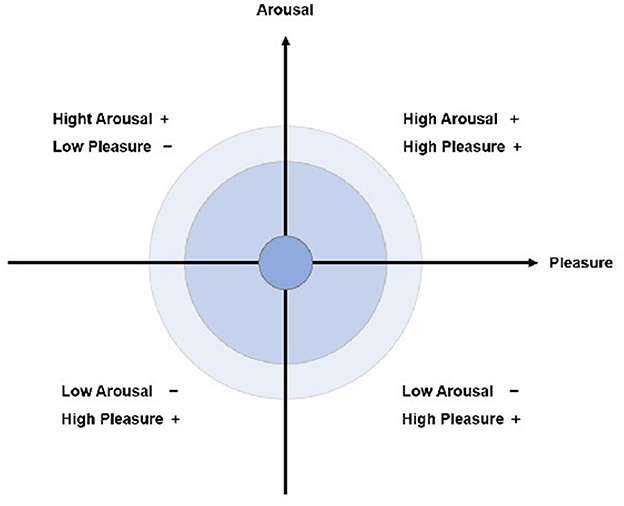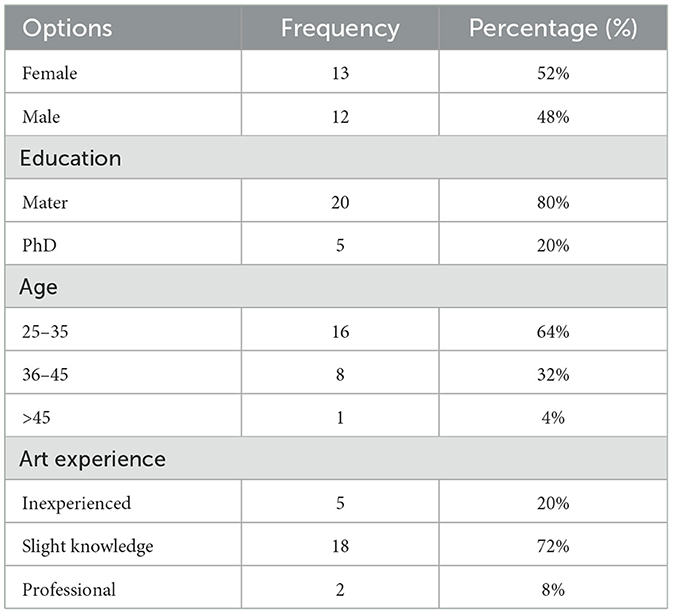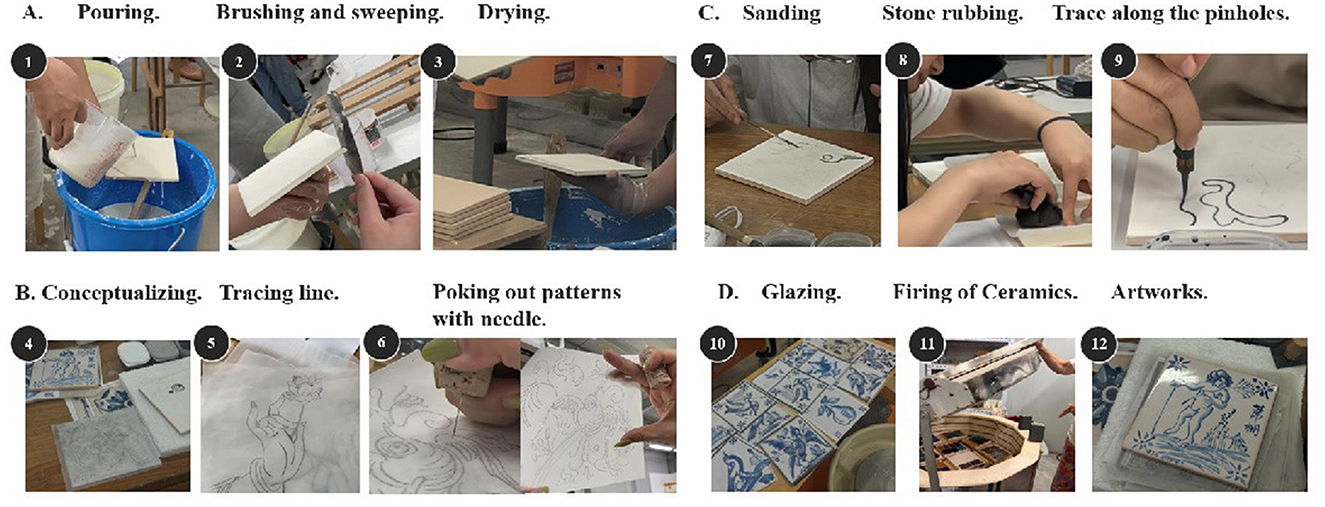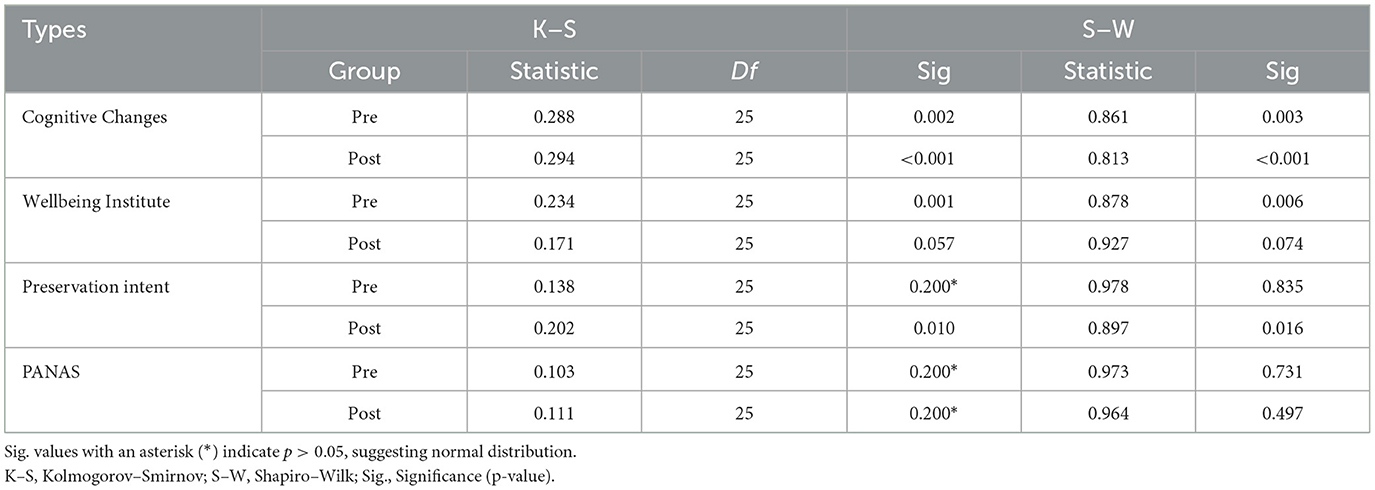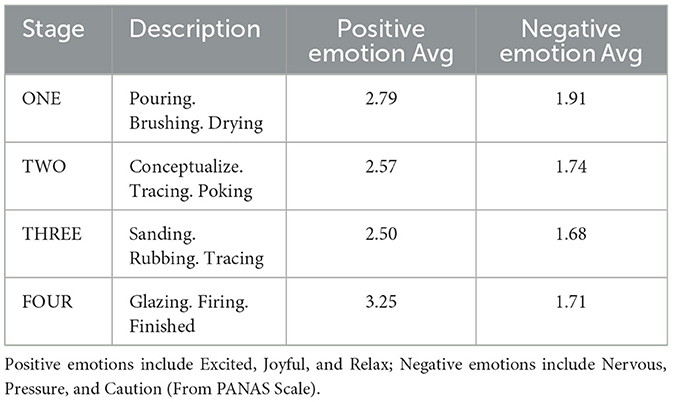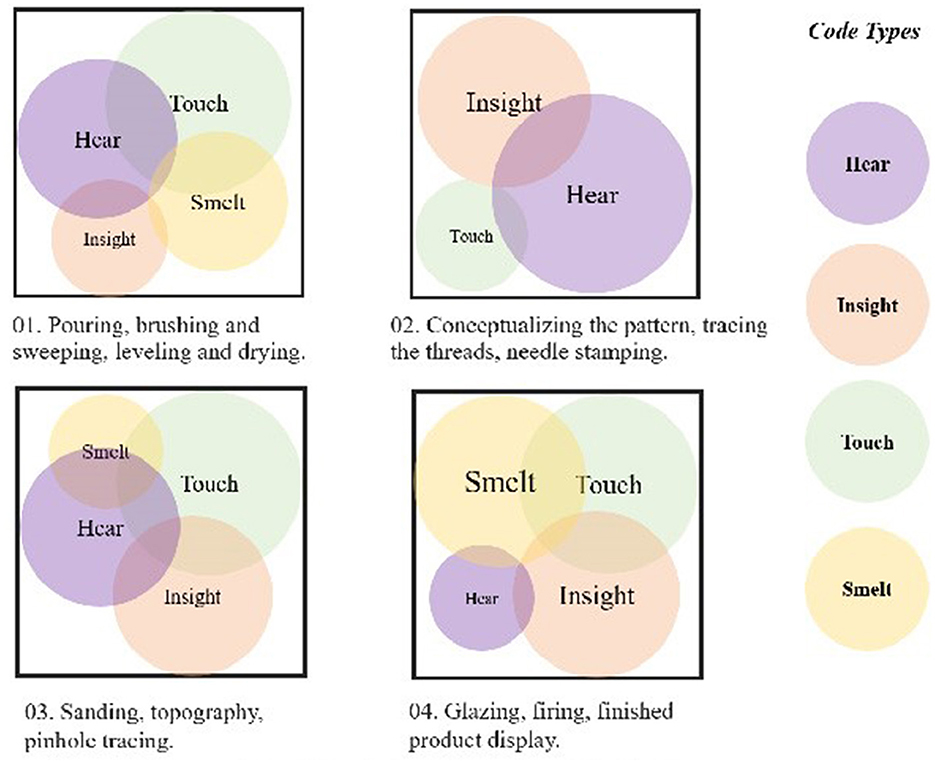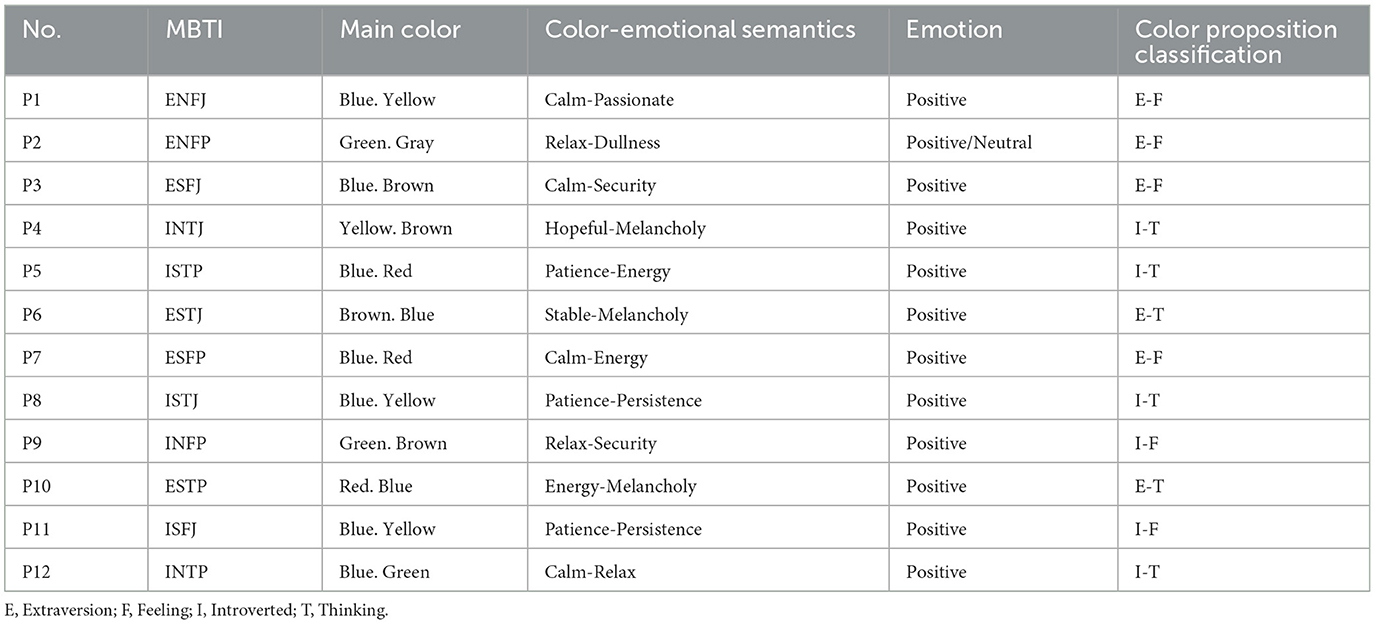- 1Faculty of Humanities and Arts, Macau University of Science and Technology, Macau, China
- 2Zhuhai M.U.S.T. Science and Technology Research Institute, Zhuhai, Guangdong, China
Background: This study investigates the therapeutic potential of the Portuguese Azulejo craft within an Arts on Prescription framework, focusing on how sensory engagement across creative stages supports the regulation of a positive emotional state, suggesting a potential U-shaped trajectory (with calming early phases and a spike of excitement in the final phase) in Portuguese Azulejo workshops. Furthermore, the study suggests a preliminary empirical relationship between MBTI personality types and color-emotion associations. Results demonstrate that multisensory engagement enhances positive affect, well-being, cultural cognition, and culture preservation intent, establishing a cognition-emotion-behaviour model for cross-cultural art interventions.
Methods: Twenty-five participants (Mean age = 34.25) took part in a cross-cultural summer workshop. Emotional states were measured pre- and post-workshop using the Cultural Cognition and Culture Preservation intent, the Subjective Happiness Scale, and the PANAS. The Wilcoxon signed-rank test assessed changes in emotion (p < 0.05). Due to sample size limitations, Pearson correlations were used to examine associations between emotional shifts and related factors (cultural cognition, culture preservation intent, well-being and affect). Spearman rank correlations were conducted to assess the relationship between creative stages and emotional response, and also attempt to analyze and compare the Myers-Briggs Type Indicator (MBTI) with the colors and emotions used in the works to dissect the impact of personality traits on emotions in the craft experience.
Results: Post-intervention, participants demonstrated significant improvements in cultural cognition (p < 0.001), subjective well-being (p = 0.003), and cultural preservation intent (p < 0.001). Positive affect, as measured by the PANAS, increased significantly (p < 0.001), while negative affect did not reach statistical significance (p = 0.16). Emotional responses varied across production stages, with initial tactile phases eliciting anticipation, mid-stage emotions stabilizing, and late-stage fluctuations linked to outcome expectations. Furthermore, participants were influenced by different patterns of MBTI personality types in terms of color use and emotional expression.
Discussion: The study underscores the therapeutic value of multisensory craft experiences, particularly the role of tactile-visual synergy in emotional regulation. Cross-cultural craft workshops support cognitive engagement, emotional well-being, and protective behaviors, highlighting their potential as group-based therapeutic interventions.
1 Introduction
Physical and mental health is a topic of concern around the world (Fan et al., 2025), and many studies have shown that (Gillam, 2018; Slanzi et al., 2023) participation in arts activities is beneficial to physical and mental health. Arts on Prescription (AoP) promotes health and wellbeing through participatory creative activities (Bungay and Clift, 2010), with participants' emotional responses influenced by environmental, cultural (Pugh et al., 2022), and interpersonal factors. To analyze these dynamics, we adopt the Emotional Arousal Model (EAM) (Berlyne, 1960; Mehrabian and Russell, 1974), which emphasizes bottom-up sensory arousal (Sodhi et al., 2016) over top-down regulatory approaches (Figure 1). However, other emotional arousal models, such as Pleasure Arousal Dominance (PAD) (Bakker et al., 2014), are more commonly used in research related to a single sense, such as touch (Guendelman et al., 2024), human-computer interaction experience (Ke et al., 2025), and detecting human emotions (Schmitz-Hübsch and Becker, 2022) under intelligent interaction. EAM's ability to map arousal-pleasure states across creative stages (Russell, 1980) addresses limitations of static outcome measures in prior craft studies (Santini et al., 2023), aligning with the tactile-visual synergy of Portuguese Azulejo workshops. In previous studies, EAM has shown efficacy in depression treatment (Missirlian et al., 2005) and emotional enhancement in healthy populations (Jensen et al., 2023), supporting its use in “art prescriptions” for sub-optimal health (Sumner et al., 2019). Although the “art prescription” is not disease-specific, this study hopes to focus on the mental health of healthy people in conjunction with cultural specificities, and to prevent mental health problems through rich art therapies (Holt, 2020). Based on this framework, we expected that in this exploratory workshop, people's emotional arousal would start low (calm) in the initial touch stage and then rise to the final stage, with possible dips or stagnation in between.
Craft activities demonstrate strong associations with mental health and quality of life outcomes (Jensen and Bonde, 2018). Research (Santini et al., 2023) reveals a positive correlation between the frequency of art-driven craft participation and mental health indicators, with greater activity diversity linked to reduced depression risk. Given these findings, promoting craft activities in therapeutic settings has gained widespread endorsement (Horghagen et al., 2007). Previous research (Zhang et al., 2024) examining stress relief through ceramic workshops for college students provides valuable insights for the present investigation. While the therapeutic benefits of craft activities in promoting mental health are well-established (Bungay and Clift, 2010; Sumner et al., 2019), existing research predominantly emphasizes Western contexts and generic art forms such as painting or music. Although research on craft-based interventions acknowledges the importance of material engagement, with clay tasks demonstrating immediate calming effects on stress in university students (Van Lith et al., 2022), it often overlooks how culturally specific practices modulate emotional responses. Recent critiques highlight that AoP frameworks rarely integrate cross-cultural dynamics (Stepney, 2022), thereby limiting their applicability in multicultural settings such as Macau. Furthermore, while the Emotional Arousal Model (EAM) has been applied to explain sensory-driven behaviors in art therapy (Missirlian et al., 2005; Sodhi et al., 2016), its potential for dissecting stage-specific emotional trajectories within multisensory craft processes remains underexplored. This gap is particularly significant given emerging evidence that cultural immersion amplifies therapeutic outcomes through enhanced cognitive-emotional integration (Zhang et al., 2019; Daykin et al., 2020). Emotional arousal during craft creation is influenced (Silvia, 2005) by both the novelty of the creative medium and individual stress-coping capacity. During manual activities, participants' senses are stimulated to evoke various emotions and feelings, including patience, calmness, and surprise. Materials such as pigments and glazes used in Portuguese Azulejo tile painting provide rich tactile experiences, aligning with Xu et al.'s research demonstrating that artistic material preferences relate to psychological traits (Pöllänen, 2015), with individuals experiencing generalized anxiety showing a preference for soft (Xu and Huang, 2024), pliable media. However, research on cross-cultural workshop participation in art therapy remains limited. Macau provides a practical setting for Portuguese handicraft culture workshops, such as tile painting activities that emphasize multisensory engagement. Unlike traditional art forms like painting or music, these activities specifically engage both visual and tactile senses. The cultural specificity combined with sensory integration makes such workshops a distinct methodological approach to studying artistic and emotional expression. Research indicates that multisensory stimulation can enhance self-awareness (Pénzes et al., 2016), while variations in material fluidity, particularly through tactile interaction with mediums like ceramics or clay—have been observed to amplify emotional responses in individuals and groups (Nan et al., 2021) with indicators such as heart rate (Finck et al., 2023; D'Agostino et al., 2023) variability. This approach transcends mere technical skill acquisition, emerging as a profound mechanism for self-connection and emotional healing that addresses the current gap in cross-cultural art therapy research.
Sensory processing across varied environmental contexts influences emotional responses distinctively, with valence contingent upon specific stimuli (Rodriguez and Kross, 2023). This underpins our hypothesis within the EAM framework, which categorizes emotional effects of sensory inputs in workshop settings (Figure 2). Interaction with diverse materials modulates both emotional states (Chen et al., 2021) and heart rate variability. The auditory and visual systems, directly connected to the amygdala, trigger rapid emotional arousal (Chen et al., 2021; Collignon et al., 2008) and frequently function synergistically in emotion recognition. In our study, participants responded to glaze colors, fluid materials, and tile-tapping sounds, categorizing these visual and auditory stimuli within the high-arousal, high-pleasure quadrant (Klein et al., 2020). Visual and auditory effects manifest almost immediately (Zhao and Rice, 2024), followed by tactile input (Cruciani et al., 2021), while olfactory stimuli exhibit greater complexity. The olfactory system's proximal connection to the hippocampus generates (Arshamian et al., 2020) more persistent emotional effects. According to Russell's circumplex model, olfaction—particularly regarding salient or hazardous odors (Russell, 1980)—falls into the high-arousal, low-pleasure quadrant. Affective touch, distinguished from general tactile input, evokes enhanced associative and emotional responses, reflecting its social and neural comfort functions (Beltrán et al., 2020). Given participants' unfamiliarity with Portuguese crafts, we propose that tactile stimuli in this context induce low-arousal, high-pleasure responses, suggesting novelty and relaxation.
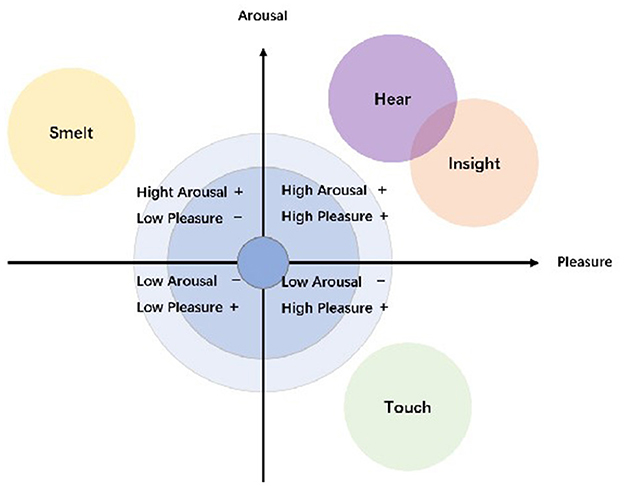
Figure 2. Categorization of different senses according to framework based on emotional arousal model.
Portuguese Azulejo painting, as a multisensory and cross-cultural artistic form, offers a unique avenue for emotional arousal and cultural cognition through its distinctive material tactility and traditional crafting processes. Specifically, the cultural cognition it engages pertains to the recognition and understanding of the historical and aesthetic context embedded in tile art. The repetitive manual actions and rhythmic motor patterns inherent in traditional craftsmanship have been shown to stimulate neural pathways associated with self-awareness (Cozolino, 2017; Nan, 2020). This study investigates the therapeutic potential of a culturally specific Azulejo tile painting workshop, grounded in the concept of “prescription art.” It seeks to elucidate how sensory engagement during various phases of creation contributes to the regulation of positive emotional states. Active participation in cross-cultural art forms, such as Azulejo, has been found to elicit more intense emotional responses than passive observation (Drake et al., 2023). While cultural background shapes individual interaction styles and feedback mechanisms within craft activities (Stepney, 2022), the underlying emotional regulation mechanisms appear to be consistent across cultural boundaries. Moreover, personal psychological identity is deeply influenced by cultural experience, which can in turn trigger physiological responses (Zhang et al., 2019; Beerse et al., 2019). Traditional culturally adaptive interventions often rely on cognitive behavioral therapy, emphasizing verbal exchange between therapist and client (Nagayama et al., 2019). In contrast, this study emphasizes non-verbal, hands-on workshops involving healthy adults in China, examining whether such culturally situated practices can promote positive emotional responses in a cross-cultural setting. To further investigate individual variability in emotional responses, this study considers the role of personality traits, particularly the Big Five dimensions and specific axes of the MBTI. Notably, the Thinking/Feeling and Introversion/Extraversion dimensions may significantly influence how individuals perceive and express emotions through artistic engagement. Engagement in cross-cultural art creation has been shown to enhance self-efficacy (Haiblum-Itskovitch et al., 2018), promote social connectivity (Daykin et al., 2020), and improve overall wellbeing. The process of craft creation also facilitates cultural integration (Kaimal et al., 2017a,b), and its emotional impacts have predictive value for the success of Art on Prescription (AoP) programs (Jensen et al., 2024). Similar to other forms of craft, Azulejo tile painting communicates deep emotional information through tactile perception and interaction with the surrounding environment (Shafir et al., 2020). This study applies the Emotional Arousal Mechanisms (EAM) framework to analyze how sensory experiences in Portuguese Azulejo workshops may lead to therapeutic outcomes. By focusing on tactile and multisensory cross-cultural engagement, it aims to identify mechanisms of emotion regulation, explore correlations between MBTI personality traits and color-emotion responses, and inform culturally informed art therapy practices in the multicultural context of Macau.
2 Methods
2.1 Participants
A total of 25 craft participants were recruited for the study, with 13 females and 12 males, from various locations throughout China, including Nanjing, Beijing, and Jiangsu (National Open Recruitment). The average age of the participants was 34.25 years (Table 1). The workshop was overseen by art specialists in Portugal, a senior researcher in the field of tile painting from Portugal, who provided expert guidance throughout the process. Furthermore, the materials and production processes utilized in the workshop were meticulously executed under the guidance and confirmation of professionals with backgrounds in fine arts and design.
2.2 Outcomes measures
In this paper, the process of tile painting is divided into four stages involving four sensory experiences: visual, tactile, and a small amount of olfactory and auditory. We reviewed studies on art therapy and emotional arousal (Hadavi et al., 2022; Michalos and Kahlke, 2008), employing the subsequent three validated scales, each utilizing a five-point Likert scale, to assess participants' emotional shifts pre- and post-intervention. Subsequently, the results of the Wilcoxon signed-rank test were used to determine whether there was a difference in emotional changes before and after the workshop. Moreover, this study combines the Myers-Briggs Type Indicator (MBTI) personality (Myers et al., 1998) with the use of color and emotional expression in the works to deconstruct the role of personality traits on emotion-color associations in craft experience (Joshanloo, 2017), hoping to capture the subconscious emotional representation (Huang, 2024) in cross-cultural craft workshops. The MBTI analysis be used in this paper is still an exploratory attempt. Two researchers coded the units into the following points: first, the color type (such as blue or red). Second, the emotional keywords that participants were asked to answer in the questionnaire (for example: I just used a lot of blue because I felt calm inside). Finally, the two coders constructed the color-emotion association based on the relevant color psychology (Elliot and Maier, 2012) and literature.
2.3 Cultural cognitive and cultural preservation intent
The complete scale of cultural attachment has 20 questions (Hong, 2017), including questions about cultural identity, cultural preservation intent, cultural dependence, and cultural cognition. Since identity dependence requires long-term contact to accumulate and form (Hong et al., 2000), and cultural preservation intent can produce cognitive and emotional changes in a short period of time, we extracted questions about cultural preservation intent (Hong et al., 2016) to collect data. Participants need to select their degree of agreement with each statement on the spot, from 1 (“strongly disagree”) to 5 (“strongly agree”).
2.4 Subjective wellbeing scale (SWB)
Subjective wellbeing (SWB) constitutes a comprehensive construct encompassing individuals' affective states, satisfaction across various life domains, and overall assessments of life quality, which were quantified using five single-item indicators (Diener et al., 1985), each evaluated on a 1–5 Likert scale and analyzed independently. While primarily reflecting social wellbeing metrics, this measure also incorporates a subjective personal component that shapes an individual's perception (Arrondo et al., 2020) of their overall life experience.
2.5 The short-form positive and negative affect scale (PANAS)
The short-form Positive and Negative Affect Scale (PANAS) effectively measures emotional fluctuations (Thompson, 2007) and was used in this study. Negative affect (items 1–5) and positive affect (items 6–10) were rated on a 1–5 Likert scale. Research indicates that initial exposure to Portuguese handicrafts influences participants' positive emotions, shaping overall satisfaction and post-experience decisions (Zhao et al., 2020), supporting the role of positive affect in craft workshops.
2.6 Procedure
The workshop was conducted during the summer of 2024 at the ceramics studio in Macau over 2 months. The tile drawing production cycle comprises four distinct phases (Figure 3). The first phase involves brush sweeping, clay brushing, end flattening, and drying; the second phase encompasses motif conceptualization, line tracing, and pin-stamping; the third phase includes sanding, patting, and pinhole tracing; the final phase consists of celadon glaze application and firing. Participants were allowed to choose any colors and were instructed to select colors that expressed their momentary emotions. Notably, beyond designing tile patterns, specialists must produce blank tiles for subsequent drawing. Throughout all four phases, participation from both a Fine Arts professor and a Portuguese expert serving as lead lecturer is essential. It was considered a public involvement activity, and all participants gave informed consent before taking part.
2.7 Data analysis
In this study, all data were analyzed using IBM SPSS Statistics 29.0.2.0 software. Initially, descriptive statistics (mean, standard deviation) were calculated to illustrate participants' emotional fluctuations before and after the experience. The Kolmogorov-Smirnov and Shapiro-Wilk tests were conducted to assess the normality of the data distribution prior to further statistical analyses. Subsequently, the Wilcoxon signed-rank test was applied to assess the statistical significance of mood changes following participation (p < 0.05). Given the limited sample size, Pearson Correlation Analysis was employed to examine relationships between mood alterations and other relevant variables (culture cognition, wellbeing, culture preservation intent, emotion). To examine the relationship between production stage and emotional responses, Spearman's rank correlation coefficient analysis was conducted. In addition, all participants had already taken the MBTI official inventory and stated their four-letter type, and then, psychology and art therapy experts conducted a simple emotional analysis of the participants' works based on the Myers-Briggs Personality Profile (MBTI) during the creative process through the color selection of the works and emotional keywords in the interviews. We established the theme coding framework based on the actual data as follows: first, the color type (such as blue or red); second, the emotional keywords that participants were asked to answer in the questionnaire (such as “I just used a lot of blue because I felt calm”). Finally, we established a theme coding framework based on actual data including: color type (blue, red); emotional keywords from questionnaires (“I just used a lot of blue because I felt calm”); and color-emotion associations constructed by two coders using relevant color psychology literature (Elliot and Maier, 2012). Since only 12 of the collected works were allowed to be made public, the Art therapy experts analyzed participants' works using the Myers-Briggs Personality Profile (MBTI) and evaluated emotional changes through color selection and interview keywords.
3 Results
3.1 Primary outcomes
As evidenced in Table 2, pre-test data exhibited significant p-values (p < 0.05) in both the Kolmogorov-Smirnov and Shapiro-Wilk tests, indicating a non-normal distribution. Likewise, post-test data from the experimental group demonstrated significant p-values (p < 0.05) in normality tests (Table 3). Wilcoxon signed-rank tests were therefore conducted to assess the changes before and after the art-based intervention. Participants exhibited significant changes across several outcome dimensions following their participation in the Portuguese tile painting workshop. Specifically, cultural cognition scores increased significantly (W = 0, p < 0.001, r = 0.874), with the median rising from 15 [IQR = 11–16] to 17 [IQR = 16–20]. Similarly, wellbeing scores improved from a median of 37 [36–41] to 45 [40–51] (W = 0, p < 0.001, r = 0.874). A statistically significant increase was also observed in protective behavior (W = 0, p < 0.001, r = 0.874), with median scores increasing from 37 [35–39] to 43 [40–47]. Concerning affective outcomes, positive affect (PA) scores decreased slightly from a median of 39 [35–41] to 36 [34–38], though this change was statistically significant (W = 38, p = 0.004, r = 0.670). In contrast, negative affect (NA) did not reach statistical significance (p = 0.16), indicating that the workshop may have had limited impact on reducing negative emotions. Furthermore, regarding emotional variations within the subject group, an intriguing differential pattern emerged. PANAS positive affect scores increased significantly (p < 0.001), demonstrating the workshop's efficacy in promoting positive emotional experiences. However, PANAS negative affect did not reach statistical significance (p = 0.16), indicating that the art workshop may be more adept at enhancing positive emotions rather than directly diminishing negative ones. Descriptive statistics (means, standard deviations, medians, and IQRs) for all outcome variables are also provided in Table 3.

Table 3. Wilcoxon signed-rank test between pre- and post-workshop experience and different influencing mood elements.
3.2 Secondary outcomes
To examine the relationship between the different stages of tile production and emotional responses, Spearman rank correlation coefficient analyses were conducted, as shown in Table 4. Several notable findings emerged across the four stages of Azulejo craft production, revealing strong negative correlations between production stage and negative emotional states, particularly for Nervous (ρ = −0.850) and Caution (ρ = −0.850), suggesting that these emotions consistently declined as participants progressed through the workshop. In contrast, positive emotions were weakly and positively correlated with production stage, with Excited showing a moderate positive correlation (ρ = 0.400), while Happy and Relaxed showed weak positive correlations (ρ = 0.200). Although only the correlations between Excited and both Joyful and Nervous reached statistical significance (p < 0.05), this may be due to the small number of stages analyzed. However, the size of the correlation coefficients suggests meaningful emotional patterns. These patterns are worth considering in the context of craft therapy, which relies on deep emotional engagement. Notably, the variance in emotional responses was strongly positively correlated with progression across stages (ρ = 0.800), indicating that emotional variability increased as participants approached the completion of their work.
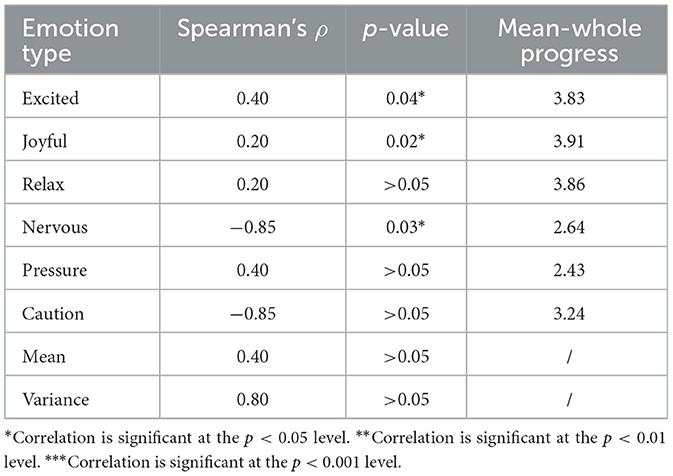
Table 4. Spearman rank correlation coefficient analysis results of the relationship between different production stages and emotions.
Moreover, as shown in Table 5, notable emotional fluctuations were observed across the four production stages. The average scores for positive emotions (including excitement, joy, and relaxation) followed a biphasic trajectory throughout the process (initial calming followed by end-heightened arousal), whereby We attempted to show that the visual, tactile, auditory, and olfactory senses involved in the participants' emotions were co-expressed and that there were differences in sensory dominance at different stages (Figure 4). Participants initially reported moderately high levels of positive affect during the early stages of engagement (casting, scrubbing, and drying; M = 2.79). These levels slightly decreased during the conceptualization and outlining phase (M = 2.57), reached their lowest during the intermediate restoration and adjustment phase (M = 2.50), and then rose sharply during the final stage of glazing, firing, and finishing (M = 3.25). In contrast, negative emotions (such as tension, stress, and a sense of burden) demonstrated a general downward trend across the first three stages (declining from M = 1.91 to M = 1.68), but showed a slight increase in the final phase (M = 1.71). Participants' tension tended to rise in the final stage of the process, potentially reflecting the demands associated with task completion.
The MBTI does not directly determine color mood, but it does provide a cognitive-emotional perspective that explains different color choices. We sorted out the emotional keywords of the participants during the coloring stage, and based on Elliot's research results on the correspondence between colors and emotions (Elliot and Maier, 2012), we constructed the color-color correspondence shown in Table 6. All the content revolved around their subjective understanding of colors and emotions during the painting process. The color tendencies and emotional associations of different personality traits are shown in Table 7. This time, two independent researchers conducted the coding, and the consistency was evaluated using Cohen's Kappa, with a result of κ = 0.76, indicating good coding consistency. Analysis of participants' color choices revealed systematic patterns between MBTI personality traits and emotional expression. Feeling-type (F) predominantly selected blue combinations, with Figure 5 confirming their strong preference for blue (25%), green/grey (21%), and brown (13%). These selections corresponded with emotional associations of “calm,” “patience,” and “security.” Thinking-type (T) exhibited a marked preference for brown (32%) and blue (25%), with yellow (14%) also featuring prominently. Extraverted-types (E) tended toward energetic color combinations, with blue (23%) and green (20%) dominating their palette. Introverted participants (I) selected colors associated with patience and stability, distributing their preferences equally among blue, yellow, and brown (each 25%), while notably avoiding red completely. These consistent alignments between MBTI characteristics and color-emotion associations suggest personality traits may influence both color selection and emotional processing.
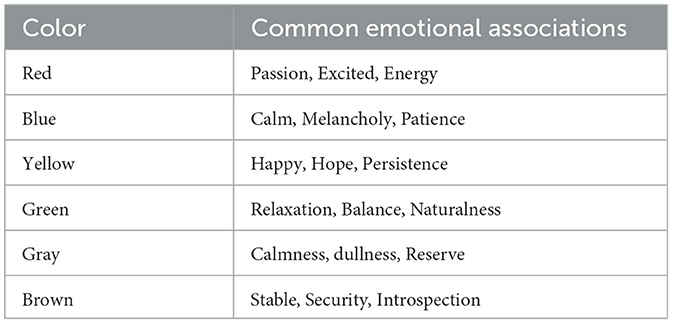
Table 6. The relationship between glaze color and craftsman's emotional association based on the results of color psychology.
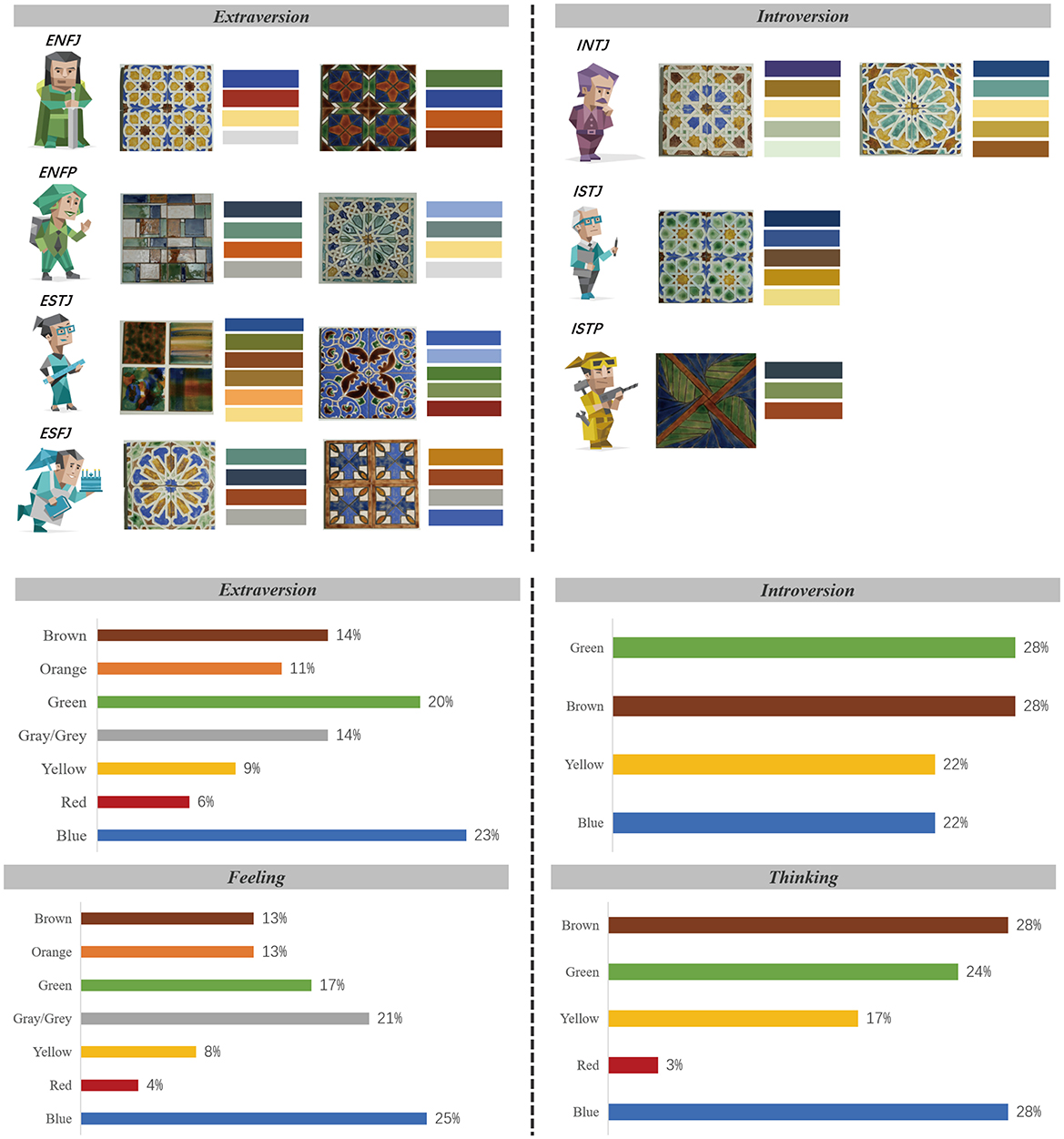
Figure 5. Based on the picture and emotions under MBTI & Color tendencies under the influence of MBTI traits.
4 Discussion
This study employs emotion-tracking methodologies to evaluate the artistic experience of participants in cross-cultural workshops, assessing its correlation with health regulation. This facilitates real-time health feedback from art workshop engagement, potentially serving as a mechanism for future health modifications in targeted applications.
4.1 The healing potential arising from multisensory experiences
In the process of creating Portuguese Azulejo tiles, the coordination of clay, pigments, and tools requires continuous limb coordination to shape raw tiles before drawing, with these soft and flexible art materials—characterized by lightness and expressiveness—offering timely benefits for participants experiencing tension (Nan et al., 2021) and anxiety. Compared to singular visual arts, the synchronous effect of sensory information amplifies emotional arousal and enhances (Aron et al., 2012) sensory processing sensitivity. Additionally, the flowing texture of brushing and mixing clay stimulates a free and comfortable sensation; this process (Sweeney and Homeyer, 1999) even adjusts the sympathetic and parasympathetic nervous systems. In fact, Man et al. (2014) found that long-term engagement in art workshops improves hedonic capacity, vivid inner imagery, and flow states. The process of mixing pigments (Holt, 2018), brushing clay, and imprinting toner generates a rich continuum of sensations, where hand contact with materials elicits positive or negative feelings based on varying pressure. Tactile perception through the skin forms mental imagery, as if awakening “eyes” in the skin, broadening the scope of emotional arousal (Grunwald, 2008). The observed emotional fluctuations align with the sensory-mediated framework proposed in our theoretical model, wherein the early touch-dominant stages and the final vision-dominant stages of production elicit the most pronounced positive emotional responses. The intermediate phases of production, which demand greater precision and technical focus, were associated with comparatively subdued emotional states, possibly reflecting the heightened cognitive and attentional demands characteristic of these stages. Notably, despite the overall positive tone in the final stage, participants' tension tended to increase. This parallels findings from the performance psychology literature, such as the growth in anxiety observed between anticipation and task completion in speech performance tasks, characterized by heightened arousal (Harris et al., 2023) when finishing goal-oriented actions. This increase may be attributed to heightened anticipation and the pressure to finalize the product, consistent with prior findings on performance-related stress in evaluative or outcome-oriented contexts. Overall, these findings support the hypothesis that emotional arousal systematically varies across the sensory-dominant stages of the Azulejo production process, with emotional elevation particularly evident during the initial material engagement and the final artistic culmination. Here, touch encompasses the abstract sensation of bodily experience (Elbrecht and Antcliff, 2014), and these materials are intertwined with multidimensional sensory factors that collectively influence the impact of art on the human psyche and quality of life. This relates to the conjecture we attempted in the Introduction that the “tactile” perception of art materials is related to the enhancement of certain positive emotions (pleasure).
4.2 The appeal of cross-cultural craft activities
Previously, teams addressing psychological issues during the COVID-19 period used multimodal art creation across nations to alleviate distress, finding that (Elbrecht and Deuser, 2012) art experiences effectively redirect negative attention. Although emotion research focuses on facial and vocal expressions, extending exploration of multicultural dimensions through bodily senses yields distinct outcomes (Porto et al., 2021), with physical movements and postures comprehensively promoting (Corem et al., 2015) emotional regulation. In most group-based craft therapy workshops (Leichner et al., 2014), participants are encouraged to work together as a group to improve social skills (Dael et al., 2012) and reduce loneliness. In addition, we fully agree that practical applications still need to adjust the form of craft participation in combination with local cultural characteristics. Gender and age may indirectly affect emotional responses through variables such as personality traits and technology familiarity (Bandura, 1997), but existing data have not found that they significantly interfere with the core mechanism. In fact, cultural adaptation of behavioral and health interventions is challenging, and health interventions around the world (Fischer et al., 2024) are working on this.
Moreover, the creation of Azulejo tiles demonstrates how thoughtful use of color and material can effectively convey emotion (Cavanagh et al., 2020). Warm hues are particularly associated with feelings of vitality, enthusiasm, and optimism (Çetinkaya et al., 2019). Research supports a clear link between color and emotion: artists often express their inner emotions through their work (Hinz, 2009); specific emotional responses can be tied to particular colors (Kaya and Epps, 2004); and cultural meanings further shape emotional interpretations of color—such as yellow with hope, black with despair (Meier and Robinson, 2005), and green with relaxation. These findings explain workshop observations where participants preferred bright colors while displaying positive emotions, suggesting color choices both express and reinforce emotional states (Wilms and Oberfeld, 2018). Artistic aesthetics feature bottom-up stimulus traits where artwork elements directly trigger intuitive sensory responses (Valdez and Mehrabian, 1994), their cognitive-level similarity offering clues for exploring intrinsic art perception mechanisms (Pelowski et al., 2017). These findings align with Fancourt's work demonstrating that art participation effectively enhances self-identity, elevates self-esteem, and cultivates agency (Fancourt et al., 2019), explaining the predominance of positive emotions observed during the workshop. This craft interaction, characterized by immediate feedback, increases happiness and pleasure emotions (Hermann and Geneseo, 2023) by bolstering participants' self-esteem. Fancourt's team emphasized that “art-making activities inherently promote emotion regulation strategies through embodied practice.” However, in this cross-cultural Portuguese Azulejo workshop, observational data showed transient negative emotions during technically demanding stages (such as “brushing” techniques and “stone friction” procedures). This aligns with skill acquisition theory, which posits that initial performance failures may temporarily impede emotion regulation (Bandura, 1997), explaining the persistent unmitigated negative emotions across different stages.
Despite technical challenges, the workshop's positive emotional outcomes validate Jiang's findings on the unique emotional (Jiang et al., 2025) benefits of handicrafts. This artistic form transcends cultural boundaries, suggesting craft-making functions beyond specific technical or cultural barriers through broader creative mastery and aesthetic engagement. We agree that practical applications should adapt craft participation to local cultural characteristics. Gender and age may indirectly affect emotional responses through variables like personality traits and technology familiarity (Bandura, 1997), but existing data show no significant interference with the core mechanism. Cultural adaptation of behavioral and health interventions remains challenging (Fischer et al., 2024), with global health interventions actively addressing this issue.
4.3 Emotional differences triggered by MBTI personality traits
This study investigates the emotional effects of multisensory engagement in Portuguese Azulejo craft workshops and examines correlations between MBTI personality traits, color selection, and emotional expression. Colors convey both cultural significance and universal psychological implications (Fetterman et al., 2015). Empirical research (Rusting and Larsen, 1998) supports the application of cognitive-affective models in color selection processes. Notably, Xue's machine learning analysis identified significant correlations between personality traits and color preferences (Xue and Ding, 2025), consistent with Ou et al.'s findings that the extraversion-introversion dimension substantially influences color perception (Ou et al., 2004). Specifically, extraverted individuals demonstrate preferences for highly saturated hues, while introverted individuals gravitate toward cooler, less saturated tones.
Although the MBTI is not designed to directly measure emotions, it offers an interesting perspective, particularly in the multisensory environment created in this workshop. In craft creation, these traits (Geen, 1984) influence emotional regulation by enhancing emotional expression. Participants' color choices, driven by their MBTI profiles, reveal various emotional associations. For example, individuals with a Feeling (F) preference tend to favor colors such as blue, green, and brown, which are associated with emotions of calmness, security, and patience, reflecting the warm and soothing qualities these colors evoke in an emotional context. On the other hand, Thinking (T) types, who tend to process information analytically, exhibit a preference for colors like brown, yellow, and blue, which are linked to neutral emotions such as calmness and stability, aligning with Lee's findings (Lee and Lee, 2021) that emotional stability is positively correlated with cooler tones. The preference for yellow, associated with hope and persistence, may suggest optimism and rational problem-solving behaviors in this experience. Extraverted (E) participants tend to choose colors, which our findings collectively support a link between cultural cognition, emotion, and behavioral intentions in art interventions to nature and are associated with vitality, closeness (Afzali et al., 2020; Jue and Ha, 2022), and social engagement. In contrast, Introverted (I) participants prefer softer hues like green and yellow, indicating a tendency toward calmer or more enduring emotional states (Lee and Lee, 2021) and heightened sensitivity (Christensen et al., 2020) to material textures. These patterns indirectly support the idea that extraverts are more likely to be drawn to high-energy colors, while introverts tend to favor cooler, less stimulating hues. The workshop environment, characterized by multisensory stimuli (visual, tactile, and auditory), significantly influenced emotional arousal, as indicated by participants' color preferences. Tactile interaction with materials, alongside visual cues, elicited varied emotional responses (e.g., curiosity, joy, frustration). Extraverted individuals, known for their responsiveness to external stimuli, may demonstrate heightened excitement and joy during dynamic phases of tile painting, reflected in their preference for highly saturated colors. Furthermore, extraverts are likely to experience greater positive emotional arousal during interactive activities. Conversely, introverted individuals may perceive the same activity as more soothing, engaging in introspective emotional regulation during quieter moments.
These findings suggest that personality traits may influence how individuals emotionally interact with art materials, especially in cross-cultural, sensory-rich environments. The initial exploration of MBTI and color emotions provides an interesting perspective for emotional healing interventions based on the premise of art and crafts, especially in short-term, low-threshold treatment programs like “prescription art.”
5 Strengths and limitations
This study demonstrates that Arts on Prescription (AoP) effectively improves psychosocial wellbeing through quantitative measures. However, we examined only short-term effects and lack longitudinal follow-up data on sustained emotional arousal impacts, despite verifying immediate positive emotional effects. We attempted 30-day post-intervention follow-ups but encountered significant limitations. Most healthy participants reported emotional responses as immediate workshop experiences and declined to provide follow-up feedback. Future research will address these limitations by combining physiological indicators (heart rate variability, skin conductance) with psychological assessments for objective emotional arousal verification. Studies will expand sample diversity across cultural backgrounds and age groups to examine demographic moderating effects (Adams and Osgood, 1973) and enhance cross-cultural art therapy frameworks. Including control groups will strengthen evidence for AoP's long-term wellbeing effects and underlying mechanisms.
6 Implications for practice and further research
This study confirms the therapeutic value of cross-cultural craft participation in regulating emotions through multisensory integration. It significantly enhances cultural identity and subjective wellbeing, while effectively stabilizing emotional fluctuations. It also offers a theoretical foundation for culturally informed art therapy that considers individual differences, specifically, the empirical connection between MBTI personality types and color-emotion associations. Practically, these insights enable art therapists to tailor material choices according to MBTI profiles (e.g., using tactile materials for introverts or bright colors for extroverts), refine emotional interventions by aligning sensory experiences with emotional stages (e.g., calming tactile phases followed by energizing visual ones), and support cultural institutions in designing therapeutic experiences that combine craftsmanship with emotional healing. Although centered on the case of Azulejo, the study's multidimensional and stage-based approach offers broadly transferable insights. It can inform art-based interventions across diverse settings, including hospitals (Yang et al., 2023), elder care facilities, educational institutions, community centers (Mosadeghrad et al., 2022), and corporate wellness programs. By integrating cultural immersion, sensory engagement, and personality-based customization, this research increases the actionable nature of the Art of Prescription and encourages interdisciplinary collaboration (Michelle et al., 2022) to expand its global community impact.
7 Conclusion
The multisensory engagement framework demonstrated stage-specific emotional patterns, with tactile-dominant initial phases and visual-dominant completion phases eliciting the most robust positive responses. While cultural art participation facilitates emotional expression, catharsis, and enhanced verbal communication, a systematic deconstruction of the neurobehavioral mechanisms of multisensory art experiences and quantification of perceptual channel effectiveness in emotional regulation are warranted. Furthermore, MBTI personality traits correlated with distinct color-emotion associations. These findings offer insights for developing targeted therapeutic craft interventions, providing promising directions for cross-cultural health promotion programs.
Data availability statement
The original contributions presented in the study are included in the article/supplementary material, further inquiries can be directed to the corresponding author.
Ethics statement
Ethical review and approval was not required for the study on human participants in accordance with the local legislation and institutional requirements. Written informed consent from the [patients/ participants OR patients/participants legal guardian/next of kin] was not required to participate in this study in accordance with the national legislation and the institutional requirements.
Author contributions
JX: Validation, Data curation, Formal analysis, Conceptualization, Visualization, Writing – original draft, Writing – review & editing. QW: Conceptualization, Investigation, Project administration, Visualization, Writing – review & editing. AZ: Data curation, Investigation, Project administration, Supervision, Writing – review & editing. XL: Investigation, Supervision, Writing – review & editing. GH: Funding acquisition, Project administration, Resources, Supervision, Writing – review & editing.
Funding
The author(s) declare that financial support was received for the research and/or publication of this article. This work was supported by the Macau University of Science and Technology's Faculty Research Grant (No. FRG-24–049-FA).
Conflict of interest
The authors declare that the research was conducted in the absence of any commercial or financial relationships that could be construed as a potential conflict of interest.
Generative AI statement
The author(s) declare that no Gen AI was used in the creation of this manuscript.
Publisher's note
All claims expressed in this article are solely those of the authors and do not necessarily represent those of their affiliated organizations, or those of the publisher, the editors and the reviewers. Any product that may be evaluated in this article, or claim that may be made by its manufacturer, is not guaranteed or endorsed by the publisher.
References
Adams, F. M., and Osgood, C. E. (1973). A cross-cultural study of the affective meanings of colour. J. Cross Cult. Psychol. 4, 135–156. doi: 10.1177/002202217300400201
Afzali, M. H., Stewart, S. H., Séguin, J. R., and Conrod, P. J. (2020). The network constellation of personality and substance use: evolution from early to late adolescence. Eur. J. Pers. 34, 1109–1119. doi: 10.1002/per.2245
Aron, E. N., Aron, A., and Jagiellowicz, J. (2012). Sensory processing sensitivity: a review in the light of the evolution of biological responsivity. Pers. Soc. Psychol. Rev. 16, 262–282. doi: 10.1177/1088868311434213
Arrondo, R., Cárcaba, A., and González, E. (2020). Drivers of subjective well-being in Spain: Are there gender differences? Appl. Res. Qual. Life 16, 2131–2154. doi: 10.1007/s11482-020-09862-x
Arshamian, A., Manko, P., and Majid, A. (2020). Limitations in odour simulation may originate from differential sensory embodiment. Philos. Trans. R. Soc. Lond. B Biol. Sci. 375:20190273. doi: 10.1098/rstb.2019.0273
Bakker, I., van der Voordt, T., Vink, P., and De Boon, J. (2014). Pleasure, arousal, dominance: Mehrabian and Russell revisited. Curr. Psychol. 33, 405–421. doi: 10.1007/s12144-014-9219-4
Bandura, A. (1997). Self-efficacy: The exercise of control. New York: W.H. Freeman/Times Books/Henry Holt and Co.
Beerse, M. E., Van Lith, T., and Stanwood, G. D. (2019). Is there a biofeedback response to art therapy? A technology-assisted approach for reducing anxiety and stress in college students. SAGE Open 9. doi: 10.1177/2158244019854646
Beltrán, M. I., Dijkerman, H. C., and Keizer, A. (2020). Affective touch experiences across the lifespan: development of the tactile biography questionnaire and the mediating role of attachment style. PLoS ONE 15:e0241041. doi: 10.1371/journal.pone.0241041
Berlyne, D. E. (1960). Conflict, arousal, and curiosity. New York: McGraw-Hill Book Company. doi: 10.1037/11164-000
Bungay, H., and Clift, S. (2010). Arts on prescription: a review of practice in the U.K. Perspect. Public Health 130, 277–281. doi: 10.1177/1757913910384050
Cavanagh, B., Haracz, K., Lawry, M., and James, C. L. (2020). Receptive arts engagement for health: a holistic and trans-disciplinary approach to creating a multisensory environment. SAGE Open 10:215824402097842. doi: 10.1177/2158244020978420
Çetinkaya, F., Duru Aşiret, G., Direk, F., and Özkanli, N. N. (2019). The effect of ceramic painting on the life satisfaction and cognitive status of older adults residing in a nursing home. Top. Geriatr. Rehabil. 35, 108–112. doi: 10.1097/TGR.0000000000000208
Chen, Q., Liu, Y., and Song, Y. (2021). Tactile texture experience on ceramic 3D-printed surfaces based on PAD emotion model. Proceedings of the International Conference on Applied Human Factors and Ergonomics. doi: 10.1007/978-3-030-80829-7_110
Christensen, A. P., Golino, H., and Silvia, P. J. (2020). A psychometric network perspective on the validity and validation of personality trait questionnaires. Eur. J. Pers. 34, 1095–1108. doi: 10.1002/per.2265
Collignon, O., Girard, S., Gosselin, F., Roy, S., Saint-Amour, D., Lassonde, M., et al. (2008). Audio-visual integration of emotion expression. Brain Res. 1242, 126–135. doi: 10.1016/j.brainres.2008.04.023
Corem, S., Snir, S., and Regev, D. (2015). Patients' attachment to therapists in art therapy simulation and their reactions to the experience of using art materials. Arts Psychother. 45, 11–17. doi: 10.1016/j.aip.2015.04.006
Cozolino, L. J. (2017). The neuroscience of psychotherapy: Healing the social brain. New York: W.W. Norton and Company.
Cruciani, G., Zanini, L., Russo, V., Mirabella, M., Palamoutsi, E. M., and Spitoni, G. F. (2021). Strengths and weaknesses of affective touch studies over the lifetime: a systematic review. Neurosci. Biobehav. Rev. 127, 1–24. doi: 10.1016/j.neubiorev.2021.04.012
Dael, N., Mortillaro, M., and Scherer, K. R. (2012). Emotion expression in body action and posture. Emotion 12, 1085–1101. doi: 10.1037/a0025737
D'Agostino, G., Serra, H., and Zavattaro, C. (2023). The emotional impact of cultural heritage on the public: physiological and psychological effects of multisensorial experiences. Design for Inclusion 75 doi: 10.54941/ahfe1003331
Daykin, N., Mansfield, L., Meads, C., Gray, K., Golding, A., Tomlinson, A., et al. (2020). The role of social capital in participatory arts for wellbeing: findings from a qualitative systematic review. Arts Health 13, 134–157. doi: 10.1080/17533015.2020.1802605
Diener, E., Emmons, R. A., Larsen, R. J., and Griffin, S. (1985). The satisfaction with life scale. J. Pers. Assess. 49, 71–75. doi: 10.1207/s15327752jpa4901_13
Drake, J. E., Eizayaga, M., and Wawrzynski, S. (2023). Making versus viewing art: effects on affect, enjoyment, and flow. Empir. Stud. Arts 42, 147–165. doi: 10.1177/02762374231196387
Elbrecht, C., and Antcliff, L. R. (2014). Being touched through touch: trauma treatment through haptic perception at the Clay Field: a sensorimotor art therapy. Int. J. Art Therapy 19, 19–30. doi: 10.1080/17454832.2014.880932
Elbrecht, C., and Deuser, H. (2012). Trauma healing at the Clay Field: A sensorimotor art therapy approach. Melbourne: Expressive Therapies Institute of Australia.
Elliot, A. J., and Maier, M. A. (2012). “Color-in-context theory,” in Advances in Experimental Social Psychology, Vol. 45 eds. Devine, P. and Plant, A. (San Diego: Academic Press), pp.61–125. doi: 10.1016/B978-0-12-394286-9.00002-0
Fan, Y., Fan, A., Yang, Z., and Fan, D. (2025). Global burden of mental disorders in 204 countries and territories, 1990–2021: results from the global burden of disease study 2021. BMC Psychiatry 25:486. doi: 10.1186/s12888-025-06932-y
Fancourt, D., Garnett, C., Spiro, N., West, R., and Müllensiefen, D. (2019). How do artistic creative activities regulate our emotions? Validation of the Emotion Regulation Strategies for Artistic Creative Activities Scale (ERS-ACA). PloS ONE 14:e0211362. doi: 10.1371/journal.pone.0211362
Fetterman, A. K., Liu, T., and Robinson, M. D. (2015). Extending color psychology to the personality realm: interpersonal hostility varies by red preferences and perceptual biases. J. Pers. 83, 106–116. doi: 10.1111/jopy.12087
Finck, C., Avila, A., Jiménez-Leal, W., Botero, J. P., Shambo, D., Hernandez, S., and Andonova, V. (2023). A multisensory mindfulness experience: exploring the promotion of sensory awareness as a mindfulness practice. Front. Psychol. 14:1230832. doi: 10.3389/fpsyg.2023.1230832
Fischer, R., Bailey, Y., Shankar, M., Safaeinili, N., Karl, J. A., Daly, A., et al. (2024). Cultural challenges for adapting behavioral intervention frameworks: A critical examination from a cultural psychology perspective. Clin. Psychol. Rev. 110:102425. doi: 10.1016/j.cpr.2024.102425
Geen, R. G. (1984). Preferred stimulation levels in introverts and extroverts: effects on arousal and performance. J. Pers. Soc. Psychol. 46, 1303–1312. doi: 10.1037/0022-3514.46.6.1303
Gillam, T. (2018). Enhancing public mental health and wellbeing through creative arts participation. J. Public Mental Health 4, 148–156. doi: 10.1108/JPMH-09-2018-0065
Grunwald, M. (2008). Human Haptic Perception: Basics and Applications. Birkhäuser Basel. doi: 10.1007/978-3-7643-7612-3
Guendelman, S., Kaltwasser, L., Bayer, M., et al. (2024). Brain mechanisms underlying the modulation of heart rate variability when accepting and reappraising emotions. Sci. Rep. 14:18756. doi: 10.1038/s41598-024-68352-4
Hadavi, S., Kennedy, K. G., Mariotti, G., and DeSouza, J. F. X. (2022). VisualEars: how an immersive art exhibit impacts mood during the COVID-19 pandemic. Front. Psychol. 13:910767. doi: 10.3389/fpsyg.2022.910767
Haiblum-Itskovitch, S., Czamanski-Cohen, J., and Galili, G. (2018). Emotional response and changes in heart rate variability following art-making with three different art materials. Front. Psychol. 9:968. doi: 10.3389/fpsyg.2018.00968
Harris, D. J., Arthur, T., Vine, S. J., Rahman, H. R. A., Liu, J., Han, F., et al. (2023). The effect of performance pressure and error-feedback on anxiety and performance in an interceptive task. Front. Psychol. 14:1182269. doi: 10.3389/fpsyg.2023.1182269
Hermann, G., and Geneseo, S. (2023). The impact of fiber arts on mental health: well-being, self-esteem, and emotion regulation. Aisthesis Int. Interdiscip. J. 14.
Hinz, L. D. (2009). Expressive Therapies Continuum: A Framework for Using Art in Therapy, 1st Edn. Routledge. doi: 10.4324/9780203893883
Holt, N. J. (2018). Using the experience-sampling method to examine the psychological mechanisms by which participatory art improves wellbeing. Perspect. Public Health 138, 55–65. doi: 10.1177/1757913917739041
Holt, N. J. (2020). Tracking momentary experience in the evaluation of arts-on-prescription services: using mood changes during art workshops to predict global wellbeing change. Perspect. Public Health 140, 270–276. doi: 10.1177/1757913920913060
Hong, Y. (2017). Cultural Attachment Theory. Intercultural Communication Core Theories, Issues, and Concepts. doi: 10.1002/9781118783665.ieicc0014
Hong, Y., Morris, M. W., Chiu, C.-Y., and Benet-Martinez, V. (2000). Multicultural minds: a dynamic constructivist approach to culture and cognition. Am. Psychol. 55, 709–720. doi: 10.1037/0003-066X.55.7.709
Hong, Y., Zhan, S., Morris, M. W., and Benet-Martínez, V. (2016). Multicultural identity processes. Curr. Opin. Psychol. 8, 49–53. doi: 10.1016/j.copsyc.2015.09.020
Horghagen, S., Josephsson, S., and Alsaker, S. (2007). The use of craft activities as an occupational therapy treatment modality in Norway during 1952-1960. Occup. Ther. Int. 14, 42–56. doi: 10.1002/oti.222
Huang, Z. (2024). Adaptive interior design method for different MBTI personality types based on generative artificial intelligence. Architectural Intelligence. doi: 10.1007/s44223-024-00066-z
Jensen, A., and Bonde, L. O. (2018). The use of arts interventions for mental health and wellbeing in health settings. Perspect. Public Health 138, 209–214. doi: 10.1177/1757913918772602
Jensen, A., Folker, A. P., Lindström, M., and Ekholm, O. (2023). Arts and culture engagement for health: a Danish population-based study. Public Health 225, 120–126. doi: 10.1016/j.puhe.2023.09.012
Jensen, A., Holt, N., Honda, S., and Bungay, H. (2024). The impact of arts on prescription on individual health and wellbeing: a systematic review with meta-analysis. Front. Public Health 12. doi: 10.3389/fpubh.2024.1412306
Jiang, X., Lu, X., Pu, M., and Li, X. (2025). The impact of craft creation practice on university students' mental health: a moderated network analysis. Front. Public Health 13:1502506. doi: 10.3389/fpubh.2025.1502506
Joshanloo, M. (2017). Factor structure and criterion validity of original and short versions of the Negative and Positive Affect Scale (NAPAS). Pers. Individ. Dif. 105, 233–237. doi: 10.1016/j.paid.2016.09.060
Jue, J., and Ha, J. H. (2022). Exploring the relationships between personality and color preferences. Front. Psychol. 13:1065372. doi: 10.3389/fpsyg.2022.1065372
Kaimal, G., Gonzaga, A., and Schwachter, V. (2017a). Crafting, health and wellbeing: findings from the survey of public participation in the arts and considerations for art therapists. Arts Health 9, 81–90. doi: 10.1080/17533015.2016.1185447
Kaimal, G., Mensinger, J. L., Drass, J. M., and Dieterich-Hartwell, R. M. (2017b). Art therapist-facilitated open studio versus coloring: differences in outcomes of affect, stress, creative agency, and self-efficacy. Can. Art Therapy Assoc. J. 30, 56–68. doi: 10.1080/08322473.2017.1375827
Kaya, N., and Epps, H. H. (2004). Relationship between color and emotion: a study of college students. Coll. Stud. J. 38, 396–405.
Ke, J., Song, H., Bai, Z., Rosenberg, M. D., and Leong, Y. C. (2025). Dynamic brain connectivity predicts emotional arousal during naturalistic movie-watching. PLoS Comput. Biol. 21:e1012994. doi: 10.1371/journal.pcbi.1012994
Klein, M., Regev, D., and Snir, S. (2020). Using the clay slip game in art therapy: a sensory intervention. Int. J. Art Therapy 25, 64–75. doi: 10.1080/17454832.2020.1713833
Lee, E., and Lee, Y. (2021). Exploring self from personality and color preference. J. Kor. Soc. Color Stud 35, 28–40. doi: 10.17289/jkscs.35.4.202111.28
Leichner, P. P., Lagarde, E., and Lemaire, C. (2014). Windows to discover: a socially engaged arts project addressing isolation. Arts and Health 6, 90–97. doi: 10.1080/17533015.2013.811276
Man, I. K., Tin, H. R., Rainbow, H., and Hung, T. (2014). Affect regulation and treatment for depression and anxiety through art: theoretical ground and clinical issues. Ann. Depres. Anxiety.
Meier, B. P., and Robinson, M. D. (2005). The metaphorical representation of affect. Metaph. Symbol 20, 239–257. doi: 10.1207/s15327868ms2004_1
Michalos, A. C., and Kahlke, P. M. (2008). Impact of arts-related activities on the perceived quality of life. Soc. Indic. Res. 89, 193–258. doi: 10.1007/s11205-007-9236-x
Michelle, P., Meera, R., and Vittoria, D. (2022). Community-based art therapy and community arts. Found. Art Therapy 493–541. doi: 10.1016/B978-0-12-824308-4.00016-8
Missirlian, T. M., Toukmanian, S. G., Warwar, S. H., and Greenberg, L. S. (2005). Emotional arousal, client perceptual processing, and the working alliance in experiential psychotherapy for depression. J. Consult. Clin. Psychol. 73, 861–871. doi: 10.1037/0022-006X.73.5.861
Mosadeghrad, A. M., Jaafaripooyan, E., and Zamandi, M. (2022). Economic evaluation of health interventions: a critical review. Iran. J. Public Health 51, 2159–2170. doi: 10.18502/ijph.v51i10.10975
Myers, I. B., McCaulley, M. H., Quenk, N. L., and Hammer, A. L. (1998). MBTI manual: A guide to the development and use of the Myers-Briggs Type Indicator, 3. Consulting Psychologists Press.
Nagayama, H. G. C., Kim-Mozeleski, J. E., Zane, N. W., Sato, H., Huang, E. R., Tuan, M., et al. (2019). Cultural adaptations of psychotherapy: therapists' applications of conceptual models with Asians and Asian Americans. Asian Am. J. Psychol. 10, 68–78. doi: 10.1037/aap0000122
Nan, J. K., Hinz, L. D., and Lusebrink, V. B. (2021). Clay art therapy on emotion regulation: Research, theoretical underpinnings, and treatment mechanisms. doi: 10.1016/B978-0-12-817933-8.00009-8
Nan, J. K. M. (2020). “From Clay to Ceramic: An Alchemical Process of Self-Transformation,” in Craft in Art Therapy: Diverse Approaches to the Transformative Power of Craft Materials and Methods, 1st Edn. ed. L. Leone. (New York: Routledge), pp. 55–71. doi: 10.4324/9781003050513-5
Ou, L-C., Luo, R. M., Woodcock, A., and Wright, A. B. (2004). A study of colour emotion and colour preference. Part III: Colour preference modeling.
Pelowski, M., Markey, P. S., Forster, M., Gerger, G., and Leder, H. (2017). Move me, astonish me, delight my eyes and brain: the Vienna Integrated Model of top-down and bottom-up processes in Art Perception (VIMAP) and corresponding affective, evaluative, and neurophysiological correlates. Phys. Life Rev. 21, 80–125. doi: 10.1016/j.plrev.2017.02.003
Pénzes, I., van Hooren, S., Dokter, D., Smeijsters, H., and Hutschemaekers, G. J. (2016). Material interaction and art product in art therapy assessment in adult mental health. Arts and Health 8, 213–228. doi: 10.1080/17533015.2015.1088557
Pöllänen, S. (2015). “Elements of crafts that enhance well-being: textile craft makers” descriptions of their leisure activity. J. Leisure Res. 47, 58–78. doi: 10.1080/00222216.2015.11950351
Porto, M., Golubeva, I. A., and Byram, M. (2021). Channelling discomfort through the arts: A Covid-19 case study through an intercultural telecollaboration project. Lang. Teach. Res. 27, 276–298. doi: 10.1177/13621688211058245
Pugh, Z. H., Choo, S., Leshin, J. C., Lindquist, K. A., and Nam, C. S. (2022). Emotion depends on context, culture and their interaction: evidence from effective connectivity. Soc. Cogn. Affect. Neurosci. 17, 206–217. doi: 10.1093/scan/nsab092
Rodriguez, M., and Kross, E. (2023). Sensory emotion regulation. Trends Cogn. Sci. 27, 379–390. doi: 10.1016/j.tics.2023.01.008
Russell, J. A. (1980). A circumplex model of affect. J. Pers. Soc. Psychol. 39:1161. doi: 10.1037/h0077714
Rusting, C. L., and Larsen, R. J. (1998). Personality and cognitive processing of affective information. Pers. Soc. Psychol. Bull. 24, 200–213. doi: 10.1177/0146167298242008
Santini, Z. I., Thygesen, L. C., Krokstad, S., Bonde, L. O., Donovan, R. J., Koushede, V., et al. (2023). Engagement with arts and culture activities in the Danish general population: Longitudinal associations with new onset or persistent depression and mental wellbeing. Br. J. Health Psychol. 28, 844–859. doi: 10.1111/bjhp.12657
Schmitz-Hübsch, A., and Becker, R. (2022). A unified valence scale based on diagnosis of facial expressions. Proceedings of the Human Factors and Ergonomics Society Annual Meeting 66, 1056–1059. doi: 10.1177/1071181322661500
Shafir, T., Orkibi, H., Baker, F. A., Gussak, D. E., and Kaimal, G. (2020). The State of the Art in Creative Arts Therapies. Frontiers Research Topics. doi: 10.3389/978-2-88963-561-0
Silvia, P. J. (2005). Emotional responses to art: from collation and arousal to cognition and emotion. Rev. Gen. Psychol. 9, 342–357. doi: 10.1037/1089-2680.9.4.342
Slanzi, C. M., Brusilovskiy, E., McCormick, B., Snethen, G., and Salzer, M. S. (2023). Participation in arts and culture among individuals with serious mental illnesses and its relationship to quality of life and recovery. Psychiatr. Rehabil. J. 46, 117–126. doi: 10.1037/prj0000553
Sodhi, K., Luthra, M., and Mehta, D. (2016). Yerkes-Dodson Law for Flow: A Study on the Role of Competition and Difficulty in the Achievement of Flow. International Journal of Education and Management Studies 6, 95.
Stepney, S. A. (2022). “Chapter 3 - Multicultural and diversity perspectives in art therapy: Transforming image into substance,” in Foundations of Art Therapy (Academic Press), 81–122. doi: 10.1016/B978-0-12-824308-4.00010-7
Sumner, R. C., Crone, D. M., Baker, C., Hughes, S., Loughren, E. A., and James, D. V. (2019). Factors associated with attendance, engagement and wellbeing change in an arts on prescription intervention. J. Public Health doi: 10.1093/pubmed/fdz032
Sweeney, D. S., and Homeyer, L. E. (1999). The Handbook of Group Play Therapy: How to Do It, How It Works, Whom It's Best For.
Thompson, E. R. (2007). Development and validation of an internationally reliable short-form of the positive and negative affect schedule (PANAS). J. Cross-Cult. Psychol. 38, 227–242. doi: 10.1177/0022022106297301
Valdez, P., and Mehrabian, A. (1994). Effects of color on emotions. J. Exp. Psychol. Gen. 123, 394–409. doi: 10.1037//0096-3445.123.4.394
Van Lith, T., Beerse, M., and Smalley, Q. (2022). A qualitative inquiry comparing mindfulness-based art therapy versus neutral clay tasks as a proactive mental health solution for college students. J. Am. Coll. Health 70, 1889–1897. doi: 10.1080/07448481.2020.1841211
Wilms, L., and Oberfeld, D. (2018). Color and emotion: effects of hue, saturation, and brightness. Psychol. Res. 82, 896–914. doi: 10.1007/s00426-017-0880-8
Xu, J., and Huang, G. (2024). The power of materials: the impact of tactile experience with biophilic materials on women's anxiety. Front. Artif. Intell. Appl. 384, 668–676. doi: 10.3233/FAIA240068
Xue, N., and Ding, J. (2025). Exploring the association between personality traits and colour saturation preference using machine learning. Acta Psychol. 253:104752. doi: 10.1016/j.actpsy.2025.104752
Yang, D., Atkin, D. J., and Labato, L. (2023). Gleaning emotions from virtual stickers: an intercultural study. Emerging Media 1, 110–130. doi: 10.1177/27523543231188778
Zhang, C. X., Fong, L. H., and Li, S. (2019). Co-creation experience and place attachment: Festival evaluation. Int. J. Hosp. Manag. 81, 193–204. doi: 10.1016/j.ijhm.2019.04.013
Zhang, X., Wen, K., Ding, H., and Zhou, X. (2024). Experiencing art creation as a therapeutic intervention to relieve anxiety—a case study of a university's ceramic art course. Front. Psych. 15:1334240. doi: 10.3389/fpsyt.2024.1334240
Zhao, R., and Rice, K. (2024). Exploring uses of visual arts-based interventions for mental health of marginalized populations: a scoping review. Arts Health 1–19. doi: 10.1080/17533015.2024.2355134
Keywords: arts therapy, multisensory, craft workshop, emotional arousal, Azulejo, behavioral healing mechanisms
Citation: Xu J, Wang Q, Zhang A, Luo X and Huang G (2025) Sensory-mediated “arts on prescription”: emotional arousal mechanisms through Portuguese Azulejo craft workshop. Front. Psychol. 16:1595856. doi: 10.3389/fpsyg.2025.1595856
Received: 27 March 2025; Accepted: 12 June 2025;
Published: 15 July 2025.
Edited by:
Anna Maria Berardi, Université de Lorraine, FranceReviewed by:
Claudio Zavattaro, University of Turin, ItalyMohd Fabian Hasna, Universiti Putra Malaysia, Malaysia
Copyright © 2025 Xu, Wang, Zhang, Luo and Huang. This is an open-access article distributed under the terms of the Creative Commons Attribution License (CC BY). The use, distribution or reproduction in other forums is permitted, provided the original author(s) and the copyright owner(s) are credited and that the original publication in this journal is cited, in accordance with accepted academic practice. No use, distribution or reproduction is permitted which does not comply with these terms.
*Correspondence: Guanghui Huang, Z2hodWFuZzFAbXVzdC5lZHUubW8=
†These authors have contributed equally to this work
 Jing Xu
Jing Xu Qianyao Wang
Qianyao Wang Aijia Zhang
Aijia Zhang Xuexing Luo
Xuexing Luo Guanghui Huang
Guanghui Huang